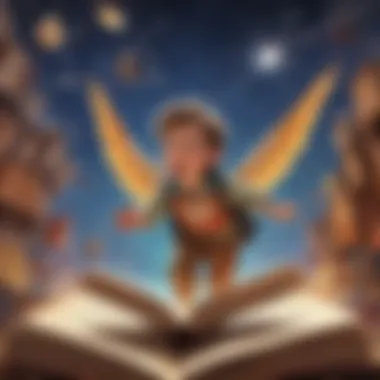Engaging Selections: Unveiling the Best Kindergarten Read Aloud Books


Fact-Based Articles
Embedded within the fabric of kindergarten read-alouds are fact-based articles that add a layer of depth and context to the literary journey. Covering a myriad of topics, these articles act as informational signposts guiding young readers through a landscape of discovery. The engaging content within these articles combines factual accuracy with a narrative flair that transforms learning into a captivating exploration of the world. Additionally, these articles serve as springboards for further exploration, offering links to additional resources that expand on the themes introduced in the read-aloud sessions. Through these articles, young minds are not only entertained but also enlightened, paving the way for a lifelong pursuit of knowledge and understanding.
Introduction
Read-aloud sessions play a crucial role in a child's early literacy development, especially in a kindergarten setting. Introducing young minds to the magic of storytelling can have a profound impact on their language skills, imagination, and comprehension abilities. In this article, we will explore the significance of read-alouds in nurturing a love for reading among kindergarten learners. By immersing children in captivating narratives at an early age, we lay a strong foundation for their academic success and cognitive growth.
Highlighting the key points that will be discussed:
- Importance of read-aloud sessions in kindergarten education.
- Benefits of incorporating read-alouds in the learning process.
- Considerations for selecting appropriate books for young readers.
Touching upon the relevance of the topic: The art of read-aloud storytelling not only entertains but also educates young listeners. It fosters a deep connection with literature and introduces them to diverse characters and narratives, expanding their horizons beyond their immediate surroundings. By selecting engaging and thought-provoking books for kindergarten read-alouds, we open doors to a world of learning and discovery for children, setting them on a path towards a lifelong love for reading and learning.
Benefits of Read-Alouds
In the realm of kindergarten education, read-aloud sessions hold a pivotal role in nurturing young minds and fostering a deep appreciation for literature. The significance of read-alouds transcends mere storytelling; it serves as a gateway to a myriad of benefits that greatly impact a child's cognitive, emotional, and social development. Through the interactive nature of read-aloud sessions, children are introduced to new vocabulary, language structures, and communication skills, which are fundamental in enhancing their language development. Furthermore, the engagement in storytelling ignites the sparks of creativity and imagination within young learners, transporting them to magical realms and new perspectives. As children actively participate in these reading experiences, their comprehension skills are honed, enabling them to make connections, infer meanings, and delve deeper into the narratives presented. The immersion in quality literature through read-alouds not only cultivates a love for reading from an early age but also lays the groundwork for a lifelong journey of learning and exploration.
Enhancing Language Development
The facet of enhancing language development in the context of read-alouds is a profound aspect that showcases the power of storytelling in enriching a child's linguistic abilities. Through exposure to a diverse range of words, phrases, and sentence structures during read-aloud sessions, children are provided with an immersive language environment that stimulates their language acquisition and fluency. By listening to the cadence and intonation of storytellers, young learners grasp the nuances of language usage, phonetics, and articulation, laying a solid foundation for effective verbal communication and expression. Moreover, the contextual cues and interactions inherent in read-aloud sessions facilitate comprehension, vocabulary expansion, and language production, shaping a child's language prowess and literacy skills from an early age.
Encouraging Imagination


Imagination serves as the playground of young minds, where creativity thrives, and possibilities are endless. Through the medium of read-alouds, children are transported into enchanting worlds, whimsical scenarios, and fantastical adventures that spur their imaginative faculties. As they listen to narratives unfold, visualize vivid descriptions, and immerse themselves in the plotlines, young learners are inspired to create their mental images, invent new ideas, and explore imaginative realms beyond the constraints of reality. The encouragement of imagination in read-aloud sessions not only fuels a child's creative expression but also enhances their cognitive flexibility, problem-solving skills, and emotional intelligence, nurturing well-rounded individuals with a vibrant inner world.
Fostering Comprehension Skills
Comprehension skills are the keystones of effective reading and critical thinking, and read-aloud sessions play a pivotal role in honing these essential skills in young readers. Through active engagement with narratives, characters, and plot developments, children are encouraged to make predictions, draw inferences, and analyze story elements, fostering their ability to comprehend and interpret textual information. The interactive nature of read-alouds prompts discussions, encourages questions, and invites reflections, enabling children to navigate complex storytelling structures, understand cause-and-effect relationships, and develop higher-order thinking abilities. By fostering comprehension skills through read-aloud sessions, educators and caregivers equip young learners with the tools necessary to navigate the vast seas of literature, encouraging them to become discerning readers, critical thinkers, and lifelong learners.
Criteria for Selection
In this intricate discussion on exploring great books for kindergarten read-aloud sessions, the selection process holds paramount significance. The criteria for choosing these literary pieces delve deep into ensuring engagement, comprehension, and educational value for the young audience. Each book handpicked for read-alouds undergoes meticulous scrutiny based on diverse factors that contribute to a holistic reading experience for kindergarteners. It is crucial to consider the engagement factor, the quality of illustrations and visual appeal, and the educational value each book offers to create a well-rounded selection that caters to the unique needs and interests of young learners.
Engagement Factor
The engagement factor plays a pivotal role in the selection of books for kindergarten read-alouds. These books are crafted to captivate young minds and sustain their interest throughout the reading session. By incorporating elements that spark curiosity, creativity, and active participation, the chosen books aim to create an immersive storytelling experience that resonates with children's imaginative faculties. Engaging narratives, relatable characters, interactive plotlines, and humor are some of the key components that contribute to the overall engagement factor of a book. This section delves into how these elements are carefully evaluated to ensure that each read-aloud session is not only enjoyable but also fosters a love for reading in kindergarten students.
Illustrations and Visual Appeal
Visual storytelling is a fundamental aspect of books designed for kindergarten read-alouds. The illustrations and visual appeal of a book play a significant role in enhancing the reading experience for young children. Vivid and expressive illustrations not only complement the text but also convey emotions, actions, and settings that may be challenging to articulate through words alone. In this section, we explore how illustrations contribute to building a holistic reading experience, stimulating children's imagination, and aiding in the development of visual literacy skills. The selection process considers the quality, style, and relevance of illustrations to ensure that they align seamlessly with the narrative and enhance comprehension for young readers.
Educational Value
Apart from being entertaining and engaging, books chosen for kindergarten read-alouds are also selected based on their educational value. These books serve as valuable learning tools that introduce children to new concepts, vocabulary, and cultural themes in an accessible and age-appropriate manner. The educational value of a book lies in its ability to expand children's knowledge, stimulate critical thinking, and promote language development. This section delves into how each selected book offers unique educational elements that align with kindergarten curriculum goals and learning objectives. By integrating educational value into the selection criteria, we ensure that read-aloud sessions not only entertain but also enrich the intellectual growth of young learners.
Top Picks for Kindergarten Read Alouds
In the realm of kindergarten read-aloud books, selecting top picks holds paramount significance. These choices pave the way for a rich and immersive educational experience for young minds. Each selection is meticulously curated to ignite curiosity, encourage active participation, and foster a love for storytelling. The essence of these top picks lies in their ability to captivate, educate, and engage kindergarteners while laying a solid foundation for language development and comprehension skills.


1. 'The Very Hungry Caterpillar' by Eric Carle
'The Very Hungry Caterpillar' by Eric Carle stands out as a cornerstone in early childhood literature. This timeless classic masterfully weaves together vibrant illustrations and simple yet profound storytelling. Through the journey of a ravenous caterpillar's transformation into a beautiful butterfly, children grasp essential concepts of counting, days of the week, and healthy eating. The book's interactive elements, coupled with Carle's signature collage art, make it a dynamic choice for fostering creativity and enhancing cognitive abilities in young readers.
2. 'Where the Wild Things Are' by Maurice Sendak
'Max, the protagonist of 'Where the Wild Things Are' embarks on a wild and imaginative journey to the land of the 'Wild Things.' Maurice Sendak's exquisite illustrations and evocative narrative provide an avenue for children to explore the depths of their imagination. Through Max's escapades with the Wild Things, readers learn valuable lessons about emotions, self-expression, and the power of love and belonging. This book not only entertains but also nurtures emotional intelligence and creativity in young listeners, making it a staple in the realm of kindergarten read-alouds.
3. 'Goodnight Moon' by Margaret Wise Brown
'Goodnight Moon' by Margaret Wise Brown is a bedtime classic that transcends generations with its soothing rhythm and comforting narrative. The gentle cadence of saying goodnight to familiar objects in a cozy room lulls children into a state of relaxation and readiness for sleep. The book's repetitive text and calming illustrations create a serene atmosphere perfect for bedtime rituals, aiding in language acquisition and promoting a sense of security in young readers. 'Goodnight Moon' is not just a story; it's a ritual that instills a sense of comfort and routine in children's lives.
4. 'Brown Bear, Brown Bear, What Do You See?' by Bill Martin Jr. and Eric Carle
In 'Brown Bear, Brown Bear, What Do You See?' Bill Martin Jr. and Eric Carle collaborate to deliver a captivating and repetitive tale that sparks curiosity and enhances memory retention. The rhythmic text paired with Carle's bold and vivid illustrations creates a multisensory reading experience for children. Through the parade of colorful animals seen by the brown bear, young readers engage in pattern recognition, color identification, and animal vocabulary expansion. This book serves as an invaluable resource for building early literacy skills and nurturing a love for exploring the world of books.
Interactive Read-Aloud Activities
Interactive Read-Aloud Activities play a pivotal role in early childhood education, especially in kindergarten. These activities not only enhance language development but also stimulate creativity and critical thinking skills in young minds. By engaging children actively during read-aloud sessions, educators can promote a deep understanding of the story and its themes. It's crucial to carefully choose activities that align with the book's content to maximize the learning experience. Furthermore, Interactive Read-Aloud Activities can help build strong teacher-student relationships and foster a positive attitude towards reading.
Character Exploration
Character Exploration is a fundamental aspect of read-aloud sessions that allows young listeners to delve into the motivations, emotions, and actions of story characters. This deep exploration aids in developing empathy, understanding cause and effect relationships, and identifying character traits. By encouraging children to analyze characters' behaviors and decisions, educators can promote critical thinking and emotional intelligence. Character Exploration also helps in making connections between stories and real-life experiences, enhancing comprehension and enabling children to relate to the characters on a personal level.


Story Retelling through Art
Story Retelling through Art is a creative way to encourage children to express their understanding of the narrative visually. Through drawing, painting, or crafting, students can reimagine key scenes, characters, and events from the story. This process not only enhances artistic skills but also improves memory retention and storytelling abilities. Additionally, Story Retelling through Art fosters imagination and creativity, allowing children to interpret the story in their unique way. Educators can use art as a tool to assess comprehension, encourage reflection, and inspire original interpretations of the text.
Role-Playing Scenarios
Role-Playing Scenarios offer children the opportunity to step into the shoes of story characters and engage in pretend play based on the read-aloud book. This activity promotes social interaction, verbal communication, and collaboration among students. Through role-playing, children can develop empathy, problem-solving skills, and narrative coherence. Educators can guide students in creating improvised scenarios or scripts inspired by the story, allowing them to explore different perspectives and generate new plot ideas. Role-Playing Scenarios not only make the reading experience more interactive but also contribute to the holistic development of young learners.
Incorporating Technology in Read Alouds
In the modern era, the integration of technology in read-aloud sessions for kindergarteners holds immense significance. By leveraging tech tools, educators can enhance engagement, interactivity, and accessibility for young learners. Incorporating Technology in Read Alouds introduces a dynamic dimension to traditional storytelling methods, offering a blend of innovation and educational value. Through the strategic use of technology, educators can cater to varied learning styles, promoting a multi-sensory approach to literary exploration.
Digital Storybooks
Digital Storybooks revolutionize the reading experience by combining visuals, sounds, and interactive elements to captivate young minds. These virtual literary works bring stories to life through animated illustrations, audio narration, and interactive features that engage children in a new realm of storytelling. By immersing children in a digital narrative, Digital Storybooks stimulate imagination, enhance vocabulary, and cultivate a tech-savvy generation of readers.
Interactive Reading Platforms
Interactive Reading Platforms empower educators to create immersive reading environments that foster active participation and comprehension. Through gamification, quizzes, and collaborative activities, these platforms make reading both entertaining and educational. By providing real-time feedback and personalized content, Interactive Reading Platforms cater to individual learning needs, promoting a personalized reading experience that motivates children to explore and engage with literary materials.
Virtual Author Visits
Virtual Author Visits transcend physical boundaries, allowing authors to connect with young readers worldwide through live video sessions. These virtual interactions not only offer children the opportunity to engage with creators but also provide insights into the writing process and storytelling techniques. Virtual Author Visits inspire a love for reading, enrich vocabulary, and create memorable literary experiences that ignite a lifelong passion for storytelling and imagination.
Conclusion
In essence, the Conclusion segment encapsulates the key takeaways from the article's exploration of great books for kindergarten read-aloud sessions. By emphasizing the fundamental role that reading aloud plays in language development, imagination enhancement, and comprehension skills cultivation, the Conclusion reinforces the importance of integrating literature into early childhood education. Through discussing the relevance of read-aloud activities as a means to engage, educate, and enchant young learners, the Conclusion cements the notion that storytelling is a powerful tool in shaping a child's cognitive and emotional growth.
Furthermore, the Conclusion section offers insight into the transformative potential of interactive reading experiences in kindergarten classrooms. By highlighting the multiple layers of educational value embedded in the act of reading aloud, the Conclusion advocates for a more immersive and participatory approach to storytelling. This, in turn, fosters a deeper connection between children and literature, laying a robust foundation for a lifelong love of reading.
Ultimately, the Conclusion section acts as a compass, guiding educators and caregivers towards a deeper appreciation of the intrinsic worth of reading aloud in nurturing young minds. By shedding light on the myriad benefits and considerations associated with incorporating read-aloud sessions in kindergarten curricula, the Conclusion empowers readers to embrace the enchanting world of children's literature, paving the way for enriched educational experiences and boundless imagination.







